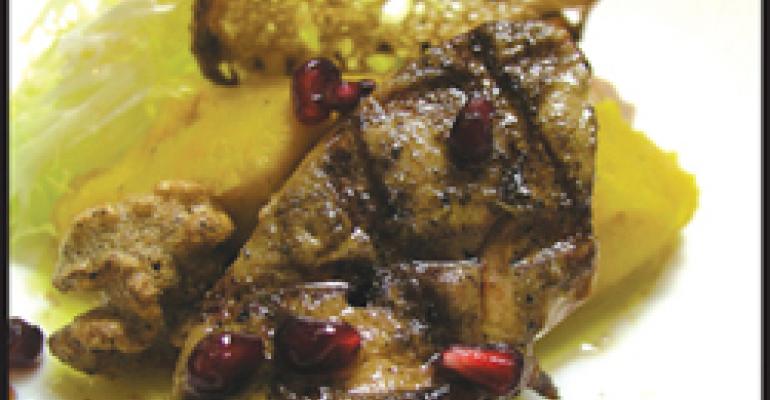It is extremely easy to be seduced by Moroccan cuisine. The cooking of this North African country is colorful and exotic, and though most of the country’s coastline is west of the Strait of Gibraltar on the Atlantic Ocean, it still embraces the familiar, sunny, style of the Mediterranean.
And as U.S. chefs are discovering, it takes very few ingredients to bring a hint of Morocco to a menu. The staples are tagines, couscous, preserved lemons, merguez, chermoula and ras el hanout. Any of these items suggests Morocco the same way wasabi immediately says Japan, or epazote offers a touch of Mexico.
At the new Amalia in New York, chef Ivy Stark serves grilled foie gras with pumpkin and walnuts and seasons it with ras el hanout, a blend of spices that often includes cumin, ginger, nutmeg, cinnamon, pepper, cardamom, cloves and fenugreek. The name means “top of the shop,” purportedly because shopkeepers and spice merchants in Morocco create their own secret blends of ras el hanout, sometimes combining as many as 50 herbs and spices.
“I spent two weeks in Morocco last fall and the flavors were amazing,” Stark said. Before taking the executive chef job at Amalia she worked at Dos Caminos, a Mexican concept with three locations in New York, and Rosa Mexicano, with locations in New York and Washington, D.C. She said the blending and roasting of spices in Morocco provides the same kind of complexity found in good Mexican cooking. She even uses Moroccan spices to season the marshmallows that accompany a tarte Tatin of caramelized Anjou pear served with a creamy Robiola cheese, passion fruit sorbet and orange blossom honey crisps.
Some of the other Moroccan terms that are showing up with increasing frequency also are worth defining. A tagine is a conical clay stovetop casserole as well as the name of the braised dish cooked in it. At InTent in New York, tagine-style eggplant is made with raisins, pine nuts and preserved lemon, and served with couscous.
Though tagines in Morocco generally are not served with couscous, chefs here tend to put the two together, so that the couscous—a granular type of semolina produced with water, then dried—can sop up the sauce.
At Fresno in East Hampton, N.Y., cumin-scented loin of lamb is served with preserved lemon, black olives, harissa and couscous. Preserved lemons, made by salting whole lemons, are now available commercially and are wildly popular. They add tang to all sorts of dishes; usually only the peel is used. At Duane Park Café in New York, a breast of free range chicken comes with a preserved lemon risotto cake and pan jus.
Willow in Arlington, Va., has concocted a Moroccan vegetable soup with preserved lemons, zucchini and oven-dried tomatoes. At Stone Park Café in Brooklyn, N.Y., tempura-fried oysters are seasoned with caper berries, preserved lemon and toasted cumin aïoli. And at Setacci in New York, grilled baby octopus comes with preserved lemons, cannellini beans and whole parsley.
Merguez is a kind of spicy lamb sausage that may be used in stews or simply grilled. At Paradou Marché in the Essex Market in New York, a choucroute is made using bacon-wrapped Berkshire pork tenderloin with merguez sausage and braised cabbage. Among the various couscous dishes offered at Marseille in New York is one with lamb kefta, or meatballs, merguez and sweet-and-spicy onion sauce.
Chermoula is a deeply herbaceous green sauce that is made with parsley, cilantro, onions, garlic, and red and black pepper. At Miriam in Brooklyn, N.Y., the sauce, turned into an emulsion, is used to season shrimp kadaif. The shrimp are wrapped in shredded phyllo.
And then there is harissa, a fiery chile sauce that has caught on here but is used much less in Morocco than in Algeria and Tunisia. La Cachette in Los Angeles serves seared Maine diver scallops in a harissa-lobster emulsion with tricolor couscous seasoned with mint, raisins, fava beans and peas. Restaurant Serenade in Chatham, N.J., combines a roasted rack of lamb with a couscous roulade, mint and tomatoes, all moistened with harissa broth.

